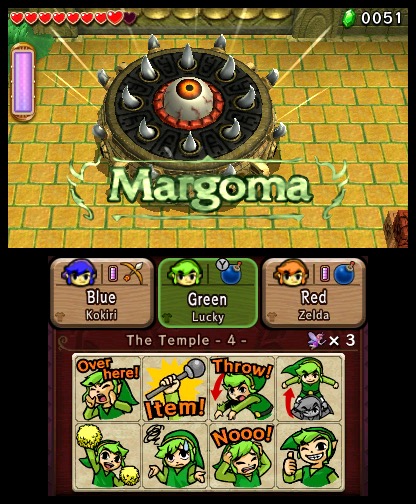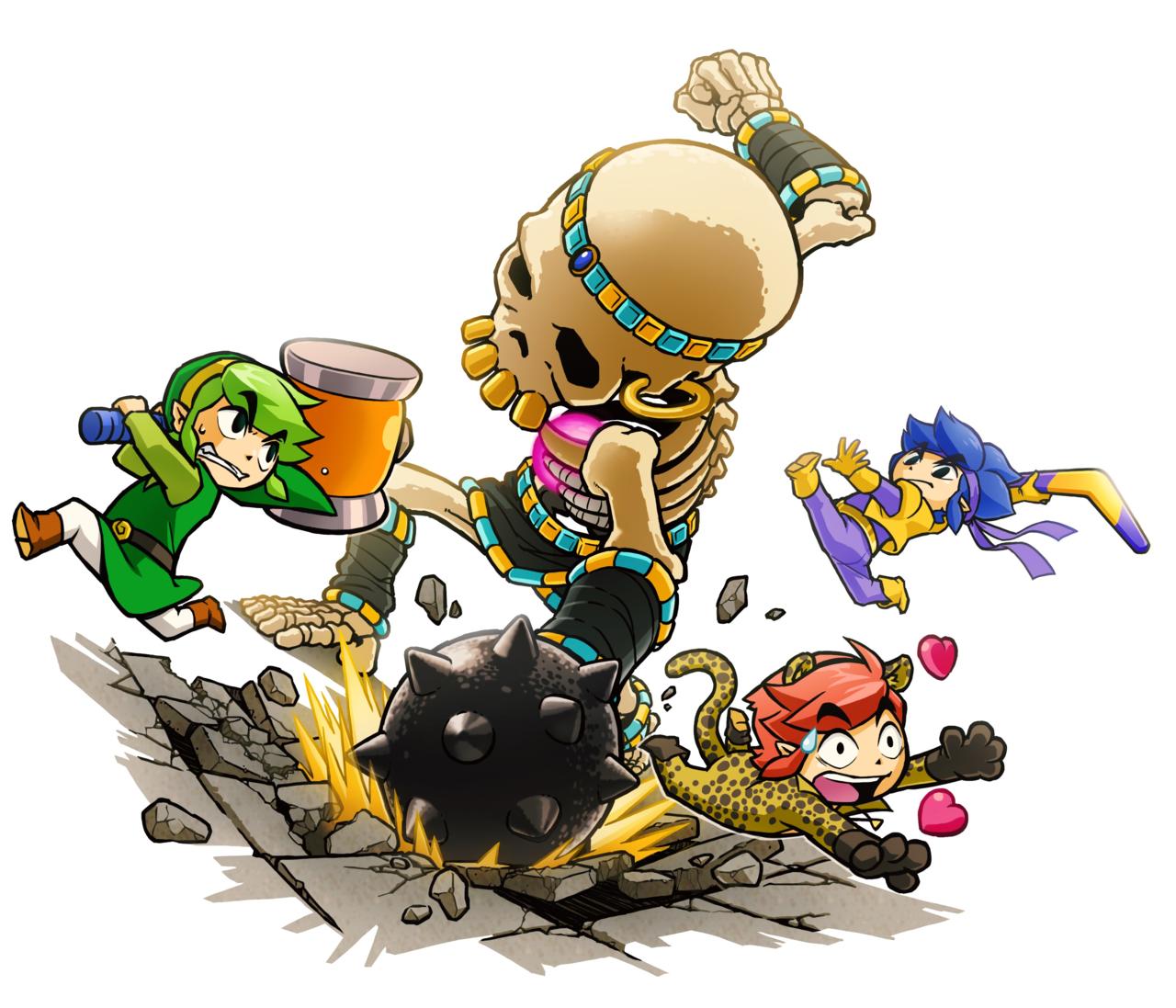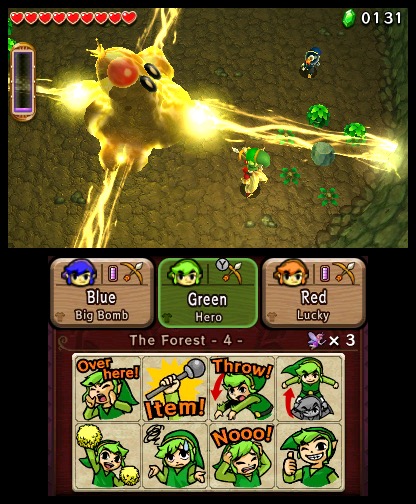The Legend of Zelda: Triforce Heroes released this weekend on 3DS and on the eve of the game's release, we talked with long-time series producer Eiji Aonuma and Triforce Heroes' director Hiromasa Shikata. While the duo didn't reveal much about the overall future for the franchise on Wii U (or NX), we did learn where Triforce Heroes fits into the overall Zelda timeline, unique items that were ultimately cut from the game, and whether Aonuma would want to try making another multiplayer Zelda game in the future.
GameSpot: Triforce Heroes is a very different kind of Zelda game. What drove the decision to make this so far out of the mold of what we might have expected from a standard Zelda adventure?
Shikata: We first wanted to focus on multiplayer, and if we did the traditional Zelda-type dungeons, it would've been a little difficult. So we thought about how we could make multiplayer easier to play.
Aonuma: We made games in the past like Four Swords, which was focused on multiplayer as well. So honestly, we believe that Triforce Heroes is almost like an evolution or a step up from Four Swords. We're a bit surprised that a lot of people are saying that it's a little unique or deviates from the traditional Zelda frame, because we built something that has been done in the past. So it doesn't detour too much from the Zelda series.
I guess when I say that it's different, that's less from a gameplay perspective. It feels like Zelda game, and it sounds like a Zelda, and the way that it looks is very much "The Legend of Zelda." When I say that it's different, it's that you're not going through an adventure to just fight the boss at the very end. The primary impetus behind what you're doing is collecting loot, and then using that loot to build new costumes. In that way it feels more like Monster Hunter or a game in that veinm rather than a standard Zelda adventure.
Shikata: With regards to collecting, in the DS games like Spirit Tracks and Phantom Hourglass, each game had a component of collecting. In Phantom Hourglass, it was collecting boat parts; for Spirit Tracks, it was train parts. So this time, when were thinking, "What can we do with three people and collecting?" it ended up being outfits. So we think we're not detouring too much from that original collecting aspect in other Zelda games.
Stellar Blade Review Nintendo 64 – April 2024 Game Updates – Nintendo Switch Online Gori: Cuddly Carnage | Meow Launch Date Announcement Trailer Marvel Rivals - Official Loki Character Reveal Trailer | The King of Yggsgard Remnant 2 - The Forgotten Kingdom | DLC Launch Trailer Stellar Blade - Official "The Journey: Part 2" Behind The Scenes Trailer | PS5 Games Another Crab's Treasure Is A Soulslike 3D Platformer | GameSpot Review Super Monkey Ball Banana Rumble - Official Multiplayer Features Trailer PUBG | Erangel Classic Returns Genshin Impact - "Arlecchino: Afterglow of Calamity" | Collected Miscellany Fortnite Festival - Official Billie Eilish Cinematic Season 3 Trailer Dead by Daylight | Tome 19: Splendor | Reveal Trailer
Please enter your date of birth to view this video
By clicking 'enter', you agree to GameSpot's
Terms of Use and Privacy Policy
The way you communicate in the game when playing with other people is fairly unique and overcomes the absence of voice chat very well. Where did the idea for using big buttons to communicate come from?
Shikata: When we started, we considered using voice chat. However, the idea came up when I was playing Four Swords with someone on the development team, someone who knew the game very well. What happened was, there was a difference between someone that knew the game and someone that didn't -- the person who knew the game was pretty much just telling the person who didn't, "Just do this. Do that." And the other person would just follow.
I didn't think that was a very fun gameplay experience. So I thought, "Perhaps there's another way to communicate that would be fun for both parties." Instead of voice chat, I came up with communication icons to convey the messages among the players.
Aonuma: It's almost like the "Like" button on Facebook. When someone presses "Like," no one really knows what that "Like" implies. Going off that idea, with these icons, it's not just a direct meaning--it hides another meaning behind it. Figuring that out ended up being pretty interesting and a good feature, so we went with that idea.

Shikata: And we have a [messaging] app in Japan called Line where you can communicate with stickers. We got some inspiration from there for the communication icons.
The addition of single-player was also an interesting solution for what is primarily a multiplayer game. Did you ever try a two-player variation? Or did that just not work out very well?
Shikata: Initially we started out with the idea of only having three players, but Mr. Aonuma stepped in and said, "Why don't you try making a single-player mode?" At first we were skeptical, but after making it, we realized that it had a different gameplay element from the three-player mode.
We tried it with two, but switching between the characters was complicated, and deciding whom to make the priority in certain situations just didn't work out. We also considered if, when somebody drops out, making the extra person a Dopple [game term for an extra player-controlled character], but even doing that made things more complicated than they needed to be. So we decided to not go in that direction.
For example, maybe the red Dopple was being moved by the green player, and he wanted to put it in the perfect spot. Then the other player comes in to try and move the red Dopple or become the Red Link. Then things just started becoming more complicated than they needed to be. That's why we took it in a different direction.
As for why we decided to have three players instead of just four, first, when you totem with four people, the two in the middle would get bored. And second, when you totem with four people, the camera angle gets very far from the ground and makes the players looks smaller. So we came to conclusion that three players were best, especially because when you have two people working together and there's one person going off on his own, the group of two will worry about the lone player. And vice versa, the player that's traveling alone will look around for the other two. It keeps everyone close together and worrying about one another.

Amiibo has also been a big part of recent 3DS and Wii U games. Was that something you considered for Triforce Heroes?
Aonuma: That was just a case where the development schedule kind of got in the way. We wanted our focus to be on getting out this multiplayer experience more than considering Amiibo. But we really wanted to, and we're hoping that, maybe in the future we can try to incorporate that in our Zelda games.
The game uses so many items and elements from the different Zelda games. How did you decide which items to use? And were there any items that you really wanted to include but that, ultimately, weren't a good fit for the puzzles and the world?
Shikata: We primarily focused on how three-player co-op would work best with the items that we chose. For example, with the boomerang, we thought it could be used to grab other players. And Gust Jars could be used to blow other players over edges that you wouldn't be able to make on your own. So when selecting and creating these items, we put an emphasis on three-person multiplayer.
We have the traditional bow and bomb items, but in this game, when you totem you can shoot higher enemies. Or when you stack up with the bomb, you can take on enemies that are higher up.

As for items that didn't make it into the game, we had a lot of different ideas. I thought about maybe using the Lantern, but that got absorbed into clothing that emits a glow. And I thought about using hover boots that would let you jump higher. And there was an item in A Link Between Worlds that shot up a gust of air to let you hover a little higher, but if we let players totem, what's the point of having that item? So there were a lot of things we considered that didn't make it into the game.
Moving over the to story, people are always excited to think about the overall timeline of the Zelda franchise. Have you given thought to where Triforce Heroes fits into the overall history and lore of series?
Shikata: This a few years after A Link Between Worlds, and that influence may be because I was also the director on that game.
Initially, the story starts with the king recruiting hero candidates, and that's where Link steps in. But there's a part of me that doesn't want people to come into the game thinking, "Is he not a hero then? Is he just a candidate?" I want to reassure people that this Link is the hero that came from the A Link Between Worlds world.
It's a little unusual for a Zelda game, but it's the same hero.
Playing through the story, the overall tone is much more light and humorous than other Zelda games. Overall, the jokes feel more like Mario and Luigi: Superstar Saga than a typical Zelda game. Was it your intention from the beginning to make this a lighter, jokier adventure?
Shikata: In this game, we definitely went for a more lighthearted story. We wanted to make the outfits the main part of the story, and then that drifted into the idea of people loving fashion. So the story became about a kingdom full of people who love outfits and clothes. If the story had focused on the princess being abducted or some other heavy theme, it would have deterred from the outfit aspect. Instead, we thought we could put the princess in this really unstylish outfit, and from there it turned into this light-hearted, joking story.
So there's no connection in this world to Ganon or other more traditional aspects, right?

Shikata: Correct, Ganon does not appear in this game. So far, in making Zelda games on the 3DS, it's been more on the light-hearted side. Nothing too heavy. So in this game, we wanted to focus on three-player. And especially since it's on a handheld system, we wanted it to be easy for anyone to pick up, understand, and just have fun with it. That's why it became the story that it is.
Aonuma: Mr. [Shigeru] Miyamoto and I actually really like creating jokey, lighthearted games. And everyone's always looking for that punch line at the end. When we make the more serious games in the series, it's a lot harder to incorporate those gags and jokes. With this game, it's very unique--the princess having an ugly outfit put on her turned into this lighthearted and fun story.
Is the team that works on mobile titles like Triforce Heroes separate from the team working on other current Zelda projects?
Aonuma: We actually have different teams. Sometimes people on the handheld team do work on the consoles, but for this it was a separate team. I want to assure you that the Wii U Zelda was not delayed in any way because of Triforce Heroes.
And we've had multiplayer Zelda games before, like Four Swords, but they're definitely few and far between. Did the experience of trying this three-player version and getting to experiment some more, did that make you feel like you'd like to try multiplayer again in the Zelda series, whether that's on console or handheld? Or does this kind of experience stay as more of a one-off thing?
Aonuma: Putting this game together, I was assured that multiplayer Zelda can be fun. And in the future, it would be great to implement this again and maybe think of new ways to try it.